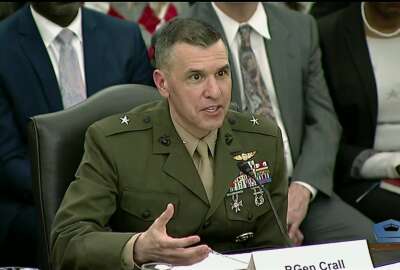Will the Air Force continue with its chief architect experiment? Kendall says maybe more is needed
Preston Dunlap announced his resignation on Monday.
The Department of the Air Force is facing an existential question over how to structure its leadership to further the advancement of technologies in a landscape that is increasingly reliant on new capabilities.
The Air Force saw its first ever chief architect, Preston Dunlap, resign Monday after three years of service, in what he called a “passing of the baton.”
Now the Air Force is questioning how it will continue to accelerate the development of technologies throughout its two military services, and that could mean the need for a chief architect is not warranted.
Air Force Secretary Frank Kendall said at the National Press Club Tuesday that the department is looking at next steps now.
“What I’m looking at right now is an organizational structure that is closer to being a program management type of structure, which has designed responsibilities of management responsibilities for the collection of the Air Force to see through battle management modernization programs,” Kendall said. “We don’t quite have that structure right now.”
Kendall noted that in the past, Air Force commands held that responsibility, but with the current structure that uses program managers with organizations overseeing individual programs, the service doesn’t have someone who is in charge of overseeing all the programs and ensuring they are tied together to perform functions as a whole.
That kind of overarching view is particularly important now because the Air Force and Defense Department are investing in technologies that build off each other. The Joint All Domain Command and Control (JADC2) program, a flagship system for DoD, brings together artificial intelligence and weapons systems over multiple domains to help make decisions faster.
Within the Air Force itself the Advanced Battle Management System (ABMS) — a subset of JADC2 — creates an internet of things approach that allows sensors and other systems to work together and share data.
“I think we need to create something that has more that kind of responsibility of tying things together,” Kendall said of the chief architect position. “I haven’t even decided what we might call it yet, but we want to move in that direction. The Navy’s doing something similar for their overmatch program for their JADC2 approach. We think that’s a pretty good model. We’re probably going to do something that looks a little bit more like that.”
The chief architect’s mission was to “lead technical architectures for the entire Air and Space portfolio to enable accelerated agile delivery of integrated warfighter capabilities in support of national security objectives.”
That included a portfolio of more than $70 billion in acquisition, research and development.
Dunlap was heavily involved in ABMS and helped oversee some of the testing.
Upon the announcement of his retirement, Dunlap wrote on LinkedIn that he felt he made meaningful change, but advised the Air Force not fall into old habits while pushing forward with new technologies.
Dunlap left a list of warnings in his resignation letter.
“Let’s be careful to not:
- Lull ourselves into complacency, when we should be running on all cylinders.
- Distract ourselves with process, when we should be focused on delivering product.
- Compete with each other, when we should be competing with China.
- Defend our turf, when we should be defending our country.
- Focus on input metrics, when we should be focused on output metrics.
- Reinvent the wheel, when we should be leveraging each other.
- Blame someone else, when we should be working on the same team.
- Do things the same way, when we should be doing things better.
- Buy the same things, when we should be buying what we need.
- Be comfortable with the way things are, when we should be fighting for the way things should be.”
Copyright © 2025 Federal News Network. All rights reserved. This website is not intended for users located within the European Economic Area.
Scott Maucione is a defense reporter for Federal News Network and reports on human capital, workforce and the Defense Department at-large.
Follow @smaucioneWFED






